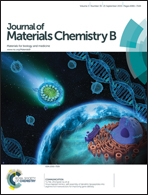A dopamine responsive nano-container for the treatment of pheochromocytoma cells based on mesoporous silica nanoparticles capped with DNA-templated silver nanoparticles†
Abstract
Owing to the over-expressed level in pheochromocytoma cells, dopamine (DA) provides a unique opportunity to design drug delivery systems for pheochromocytoma treatment. Herein, we developed a DA responsive delivery system for the treatment of pheochromocytoma cells based on mesoporous silica nanoparticles (MSNs) capped with DNA-templated silver nanoparticles (AgNPs). In this system, cytimidine-rich DNA grafted on the MSN was employed as the template to in situ drive the synthesis of AgNPs. The as-formed AgNPs were bound to the contour of DNA and blocked the pores to form the AgNPs capped MSNs (MSN@AgNPs). In the presence of DA, the capped AgNPs would break away from the surface of MSNs due to the reactivity of DA with AgNPs through the formation of Ag–catechol bonds, giving rise to the uncapped pores. Doxorubicin (DOX), as a model drug, was used to form DOX-loaded MSN@AgNPs (DOX@MSN@AgNPs) and then to assess the drug release behaviors from the DA-responsive delivery system. The in vitro studies showed that the DOX@MSN@AgNPs have a higher cytotoxicity to rat pheochromocytoma cell lines (PC-12 cells) when compared to human cervical cancer cell lines (HeLa cells). With these excellent features, we believe that this DA-triggered drug delivery system should promote the development of therapy in pheochromocytoma.


 Please wait while we load your content...
Please wait while we load your content...